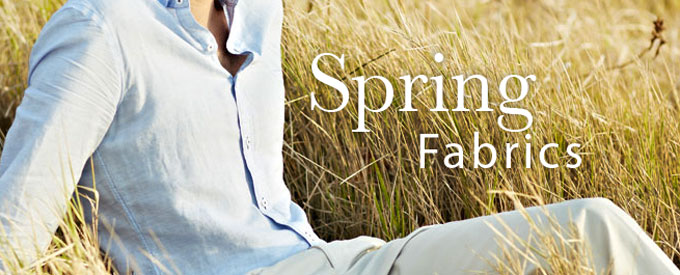
With summer just around the corner, the days are getting longer and the temperatures are on the rise. Unfortunately, so will be the humidity, at least in some parts of the globe. For every gentleman, it becomes important to dress appropriately – not only will he be concerned about style, but also about the proper materials and fabrics of his attire.
Of course, opinions are widely divided about what the best fabric is for hot and humid environments. For your reference, we have put together a short overview about the most famous of them.
1. Linen
Although used for thousands of years, Linen experienced its rise in popularity in the late 18th and early 19th century. Because of increasing prices of cotton and newly discovered methods of processing raw materials, linen became a true alternative to existing industrial fibers. Linen is processed from flax fibers, one of the oldest documented fiber crops in the world.
Linen clothes are well suited for hot and humid climates, because of a variety of unique attributes and benefits over cotton. Firstly, linen can absorb a larger amount of water from the body, up to as much as 20% of its weight. Additionally, linen is very lightweight, which makes it a preferred fabric for hot climates. Unfortunately, linen shirts are susceptive to wrinkling, especially in humidity, not to mention in rain. Therefore, it is ill-advised to wear a linen suit in a business professional environment, no matter what temperature the gentleman has to deal with. The fashion industry, however, has countered the negative attribute by combining linen with other fabrics such as cotton or silk, resulting in wrinkle resistant versions.
2. Wool
Alright, we can admit: It sounds crazy. But it’s not. Wool is a great fabric in a variety of climates: in cold climates and seasons it will keep you warm, but in hotter times it can also keep you cool. This comes from the natural coil-shaped structure of wool that helps remove moisture and heat from your body. As a matter of fact, suits made of wool not only look professional in every climate, but are also way better to wear in hot weather than, for example, cotton. Unless your cotton suit is a seer sucker, suits made of cotton are usually very tightly woven so the flow of air is minimized. If you are choosing the right wool, your suit will be a more comfortable and more stylish fit for your hot days.
So: how do I choose the right wool?
That’s actually easier to answer than expected. A complete guide to different wool fabrics can be found here on Gentleman’s Digest. For our purposes, however, it is enough to know that we have to look for wool that does not weight more than 8 ounces per yard, preferably somewhere between 6 and 7 oz. per yard.
The other dimension, the wool’s fineness, used to be measured in spools made from one pound of the raw material. Today, there is a more precise way to determine wool’s fineness, standardized by the International Wool Textile Organisation (IWTO). Normal, somewhat coarser wool usually comes with a count around 90. Then, of course, we can also find higher numbers, like the “Super 120”. The added “super” is not a quality attribute, but merely stands for “a count above 100”. The basic rule says the higher the count, the finer the touch; on the down side, higher counts are more demanding in care.
Last but not least, you want to consider the weave of your suit. Imagine a normal basket, where horizontal yarn is alternatively overlapping and passing below vertical yarn. This plain weave is better suited for hotter climates.
3. Cotton
As already indicated, cotton is probably the last choice on our list. This is mostly because of the tightness of the weave, which allows less air circulation and captures a lot of heat inside the suit. Of course, there is the one great exemption: the seer sucker suit.
The seer sucker fabric is woven using the so called slack tension weave, where two warp beams are held by different tensions: normal and slack. With the reed beating the “filling yard” into place, the yarn under slacking tension buckles and kinks, creating that puckered stripe we see on seer sucker suits.
The yarn woven under normal tension produced the normal, flat cotton surface in between the stripes.
The puckered stripes, with less density, allow the air to circulate and make the seer sucker suit a valid alternative for hotter climates.
Another cotton option for warmer weather is called poplin. As a matter of fact, poplin suits are usually a combination of lightweight fabrics (e.g. silk) and sometimes it is found in a cotton-polyester mixture, but for our purposes, we can surely deal with it under the cotton section. Since it is lightweight and usually smooth as silk, it makes a great summer suit. The elegant and smooth feel make it a great, more luxurious option for your summer wardrobe.
With the three options of linen, wool, and cotton, every gentleman should be able to assess the “summer suitability” of his wardrobe. Of course, there are huge quality spreads out there and, accordingly, prices vary significant. But with three layers – undershirt, dress shirt, and jacket – it definitely pays off to invest in the right summer suit. After all, a gentleman always keeps his cool.
Have more questions? Contact us at info@gentlemansdigest.com and we’ll get back to you.
*Pictures by J Hilburn (jacket and suit) and the world wide web (Mr. Gregory Peck)

One thought on “What to Wear: Warm Weather”
Comments are closed.